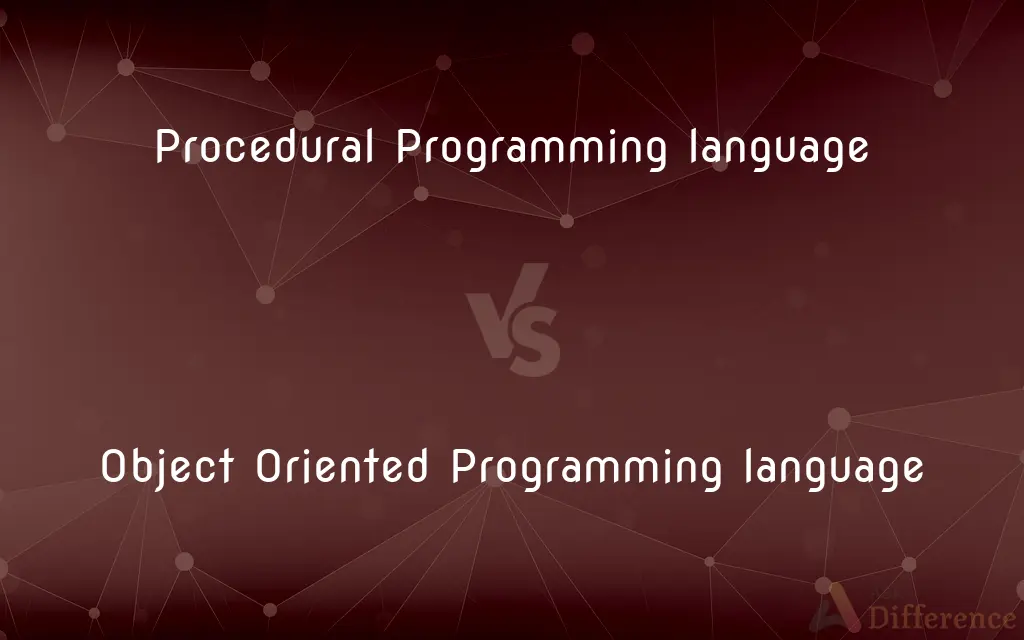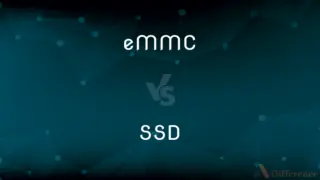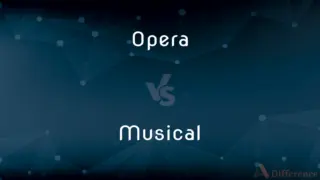Procedural Programming language vs. Object Oriented Programming language — What's the Difference?
By Tayyaba Rehman & Urooj Arif — Published on February 2, 2024
Procedural Programming focuses on procedures or routines; Object-Oriented Programming is based on objects containing data and behavior.

Difference Between Procedural Programming language and Object Oriented Programming language
Table of Contents
ADVERTISEMENT
Key Differences
Procedural Programming language emphasizes a linear, step-by-step approach where problems are broken down into a series of instructions or subroutines known as procedures or functions. It is a methodology that applies a top-down approach in program design, with a focus on the sequence of actions to be performed to attain the desired output. The main characteristic of Procedural Programming is its clear sequence of computational steps, with each step possibly altering the program's state.
Object-Oriented Programming language, on the other hand, organizes software design around data, or objects, rather than functions and logic. An object can be defined as a data field that has unique attributes and behavior. Object-Oriented Programming aims to implement real-world entities like inheritance, hiding, polymorphism, etc. in programming. It is more concerned with the objects that are manipulated rather than the logic required to manipulate them.
Procedural Programming languages are designed around the concept of procedure calls where routines or functions are written to perform certain tasks. This approach is highly effective for tasks that can be solved by following a specific sequence of steps. The logic of the program is a sequence of tasks to be done such as reading, calculating, and printing.
Object-Oriented Programming languages, however, are designed around the concept of objects that represent instances of a class. Classes are blueprints that encapsulate data for the object and methods to manipulate that data. Instead of focusing on the steps that need to be taken to achieve a task, Object-Oriented Programming focuses on the objects involved in the task and designs the program around their interactions.
In summary, Procedural Programming languages are focused on procedures and the sequence of execution, whereas Object-Oriented Programming languages are centered around objects and their interactions. The choice between the two paradigms depends on the specific requirements of the project and the preferences of the development team.
ADVERTISEMENT
Comparison Chart
Basic Unit
Function or Procedure
Object, which encapsulates data and methods
Programming Approach
Linear and sequential, focusing on the flow of the program
Based on objects and their interactions
Data Handling
Data is often passed from function to function
Data is encapsulated within objects, promoting data security
Modularity
Achieved through functions
Achieved through classes and objects
Code Reusability
Limited, as functions can be reused but might require additional coding
High, due to inheritance and polymorphism allowing for code reuse
Program Structure
Generally follows a top-down approach
Uses a bottom-up approach
Main Focus
On procedures or steps to solve a problem
On objects representing entities with data and operations
Concepts Emphasized
Procedures, local variables, global variables, sequence of actions
Encapsulation, inheritance, polymorphism, abstraction
Example Languages
C, Fortran, Pascal
Java, C++, Python, Ruby
Compare with Definitions
Procedural Programming language
Relies on a top-down approach in program design and problem-solving.
A COBOL program might start with a main procedure and branch out into smaller, specialized procedures.
Object Oriented Programming language
Focuses on abstraction, hiding complex implementation details from the user.
A Java interface can define a standard way to interact with various database systems without exposing the internal workings.
Procedural Programming language
Emphasizes the idea of breaking down a task into smaller subroutines.
In BASIC, one can use subroutines to organize code for readability and reuse.
Object Oriented Programming language
Supports inheritance, allowing new objects to take on properties of existing ones.
In C++, a 'Truck' class can inherit from a 'Vehicle' class, gaining its attributes and behaviors.
Procedural Programming language
Focuses on writing a sequence of instructions to perform a task.
Using Pascal, one can write a series of procedures to calculate and display the results.
Object Oriented Programming language
Encourages encapsulation by keeping data internal to the object and exposing only necessary functions.
A Python class can use private variables and public methods to control access to its data.
Procedural Programming language
A programming paradigm based on the concept of procedure calls.
In C, functions are used to create modular code that performs specific tasks.
Object Oriented Programming language
Centers around the concept of objects, which combine data and behavior.
In Java, you can create a 'Car' object with properties like speed and methods like accelerate().
Procedural Programming language
Utilizes variables, conditional statements, and loops to control the flow of a program.
Fortran uses loops and conditional statements to iterate over arrays for scientific computations.
Object Oriented Programming language
Utilizes polymorphism to allow different objects to be treated as instances of the same class.
In Ruby, different shapes like Circles and Squares can be treated as generic 'Shapes' with a common method to calculate area.
Common Curiosities
How does data management differ between the two?
Procedural languages manage data with functions and global variables, while object-oriented languages use encapsulation within objects.
What is an Object-Oriented Programming Language?
It's a language that models software around objects, encapsulating data and behavior in a way that mimics real-world entities.
What is a Procedural Programming Language?
It's a language that uses procedures or routines to structure code, emphasizing a step-by-step execution flow.
How does procedural programming handle modularity?
Modularity in procedural programming is achieved through the use of separate functions for different functionalities.
How does object-oriented programming handle modularity?
It achieves modularity through the use of classes and objects, allowing for clearer separation of concerns.
Can procedural and object-oriented programming be mixed?
Yes, many modern languages support both paradigms, allowing developers to choose the best approach for each task.
What's the main focus of procedural programming?
The main focus is on the sequence of operations to perform tasks, with less emphasis on the data being manipulated.
What's the main focus of object-oriented programming?
The focus is on objects that represent entities, with both data and the operations that can be performed on that data.
Can you reuse code easily in both paradigms?
Code reuse in procedural programming is limited to functions, whereas object-oriented programming supports extensive reuse through inheritance and polymorphism.
How do the two paradigms approach program structure?
Procedural programming follows a top-down approach, starting with the main function, while object-oriented programming builds from the bottom up, starting with objects.
What are examples of object-oriented programming languages?
Examples include Java, C++, Python, and Ruby.
Is one paradigm better than the other?
Each paradigm has its strengths and is better suited to certain types of problems and applications.
What are some key concepts in procedural programming?
Key concepts include procedures, local and global variables, and sequential execution.
What are examples of procedural programming languages?
Examples include C, Fortran, and Pascal.
What are some key concepts in object-oriented programming?
Important concepts include classes, objects, encapsulation, inheritance, and polymorphism.
Share Your Discovery

Previous Comparison
eMMC vs. SSD
Next Comparison
Opera vs. MusicalAuthor Spotlight
Written by
Tayyaba RehmanTayyaba Rehman is a distinguished writer, currently serving as a primary contributor to askdifference.com. As a researcher in semantics and etymology, Tayyaba's passion for the complexity of languages and their distinctions has found a perfect home on the platform. Tayyaba delves into the intricacies of language, distinguishing between commonly confused words and phrases, thereby providing clarity for readers worldwide.
Co-written by
Urooj ArifUrooj is a skilled content writer at Ask Difference, known for her exceptional ability to simplify complex topics into engaging and informative content. With a passion for research and a flair for clear, concise writing, she consistently delivers articles that resonate with our diverse audience.
















































